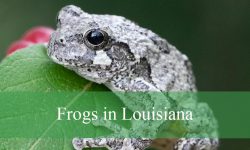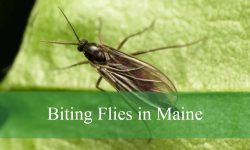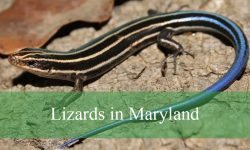California Snakes are diverse and unique, with many species found across various habitats in the state. Snakes in California range from harmless to mildly venomous. Some species are extremely dangerous due to their venom, and each is adapted to different environments, from deserts to grasslands.
Whether burrowing underground or swimming in rivers, these snakes play vital roles in the state’s ecosystems.
Keep reading to discover 53 types of snakes that can be found in California and how to identify and distinguish them.
Venomous snake species in California
Sidewinder
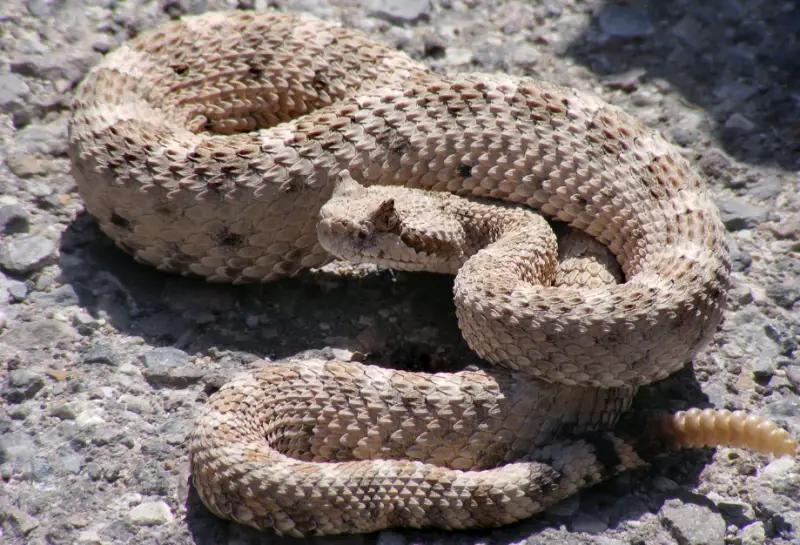
The Sidewinder (Crotalus cerastes), also known as the horned rattlesnake, is a venomous pit viper found primarily in Southern California. This small to medium-sized snake typically grows between 17 to 30 inches. Named for its unique sidewinding movement, it leaves distinctive “J”-shaped tracks in the sand, an adaptation for navigating arid environments.
Commonly seen during winter days and summer nights, the Sidewinder’s behavior shifts with the seasons to avoid extreme temperatures.
Southwestern Speckled Rattlesnake
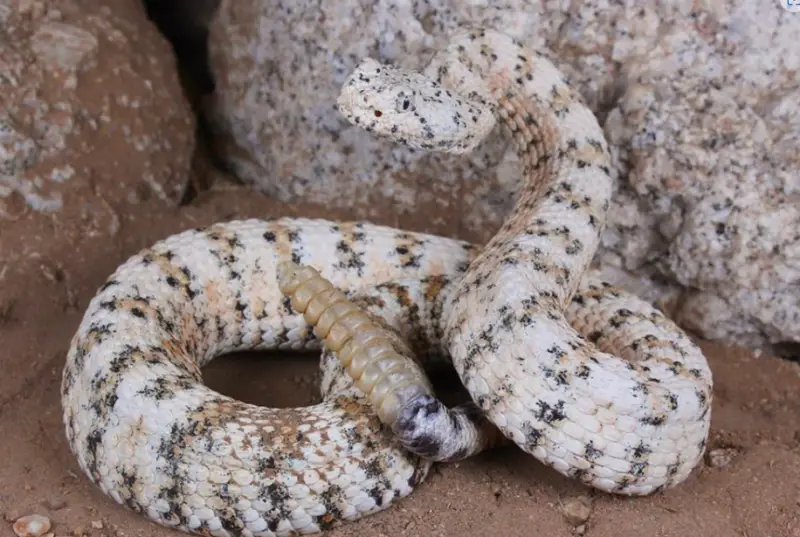
The Southwestern Speckled Rattlesnake (Crotalus pyrrhus), also known as the bleached rattlesnake, is a venomous species found in Southern California. Typically inhabiting rocky terrain like chaparral, this snake is mildly venomous, though its bite is painful and requires hospitalization with antivenom treatment.
Reaching a length of several feet, it frequently finds refuge in the burrows of mammals. In the summer, it is nocturnal; in the winter, it turns diurnal.
Mojave Rattlesnake
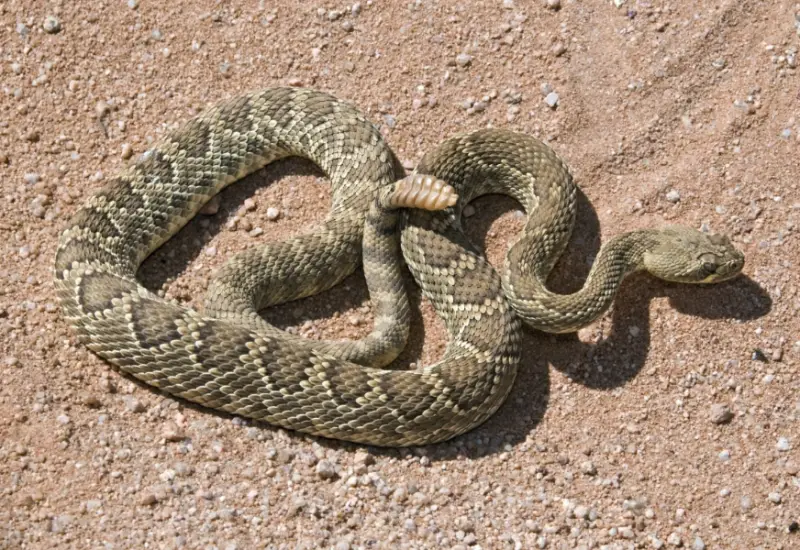
The Mojave Rattlesnake (Crotalus scutulatus), also known as the Mojave Green, is one of the most venomous rattlesnakes in the world. It typically grows between 3 to 4.5 feet and is commonly found in the Mojave Desert, particularly in southeastern California.
This snake is recognized by its gray-brown body and is known for its potentially aggressive behavior toward humans. Immediate medical attention is crucial following a bite, as its venom can be lethal without antivenom.
Panamint Rattlesnake
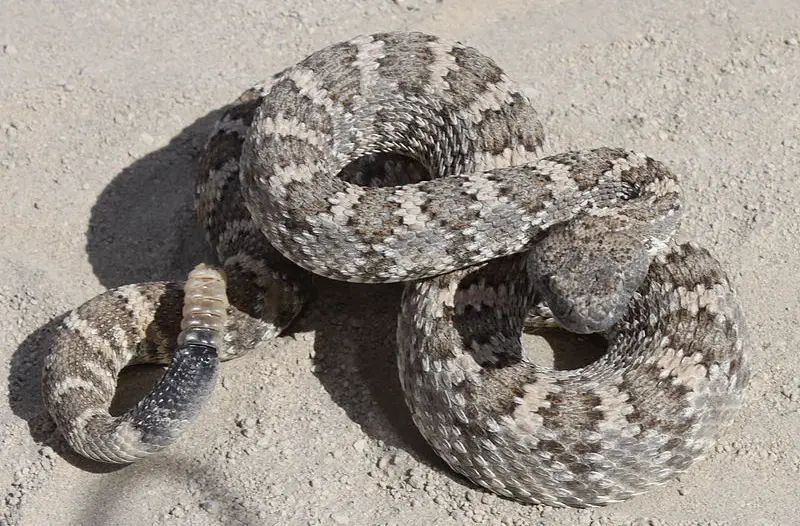
The Panamint Rattlesnake (Crotalus stephensi), also known as the Owens Valley rattler, is a venomous species found in California and Nevada. This medium to large snake grows between 2 to 4 feet and is recognized by its gray coloration and triangular-shaped head. The snake uses the tip of its tail to produce a rattling noise as a warning.
It rarely bites humans, but medical attention with antivenom is necessary if bitten. The Panamint Rattlesnake can sense heat, often retreating when it detects people or large mammals.
Western Diamondback Rattlesnake
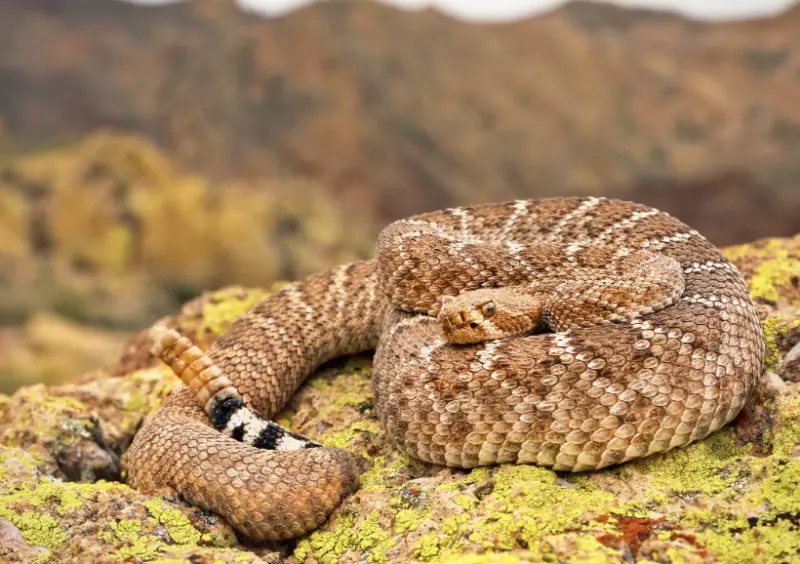
The Western Diamondback Rattlesnake (Crotalus atrox), also known as the Texas diamond-back, is one of California’s most dangerous snake species. It is characterized by a gray-brown body with distinct blotches along its dorsal side. This snake is responsible for the most common snake bites in the region.
Feeding primarily on small mammals, it overwinters in rodent burrows. Its venom is highly dangerous, capable of causing muscle destruction and internal bleeding, which can be fatal without prompt medical attention.
Western rattlesnake
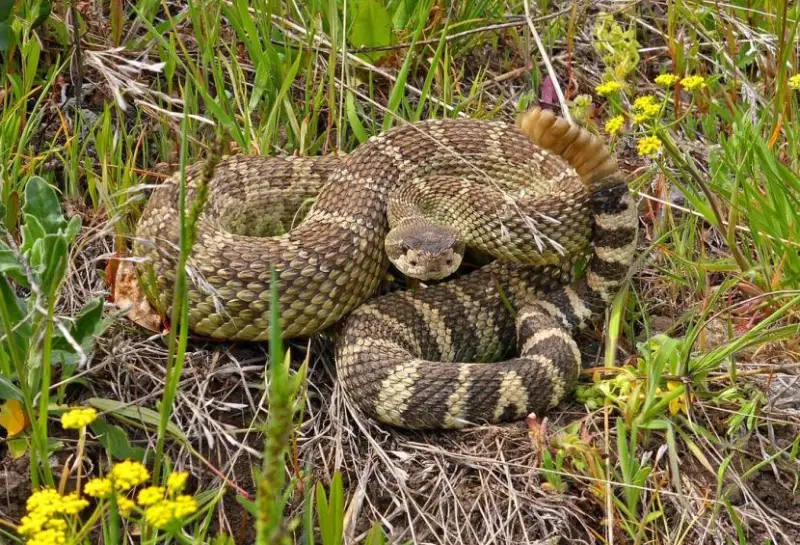
The Western Rattlesnake (Crotalus oreganus), also known as the Pacific rattlesnake, is a venomous pit viper found throughout California. It typically grows to just over 30 inches and adapts its coloration to blend with its environment.
Juveniles primarily eat insects, while adults shift to amphibians. Despite being the most dangerous snake in the region, it prefers to use its venom on small prey and usually tries to avoid humans.
Red Diamond Rattlesnake
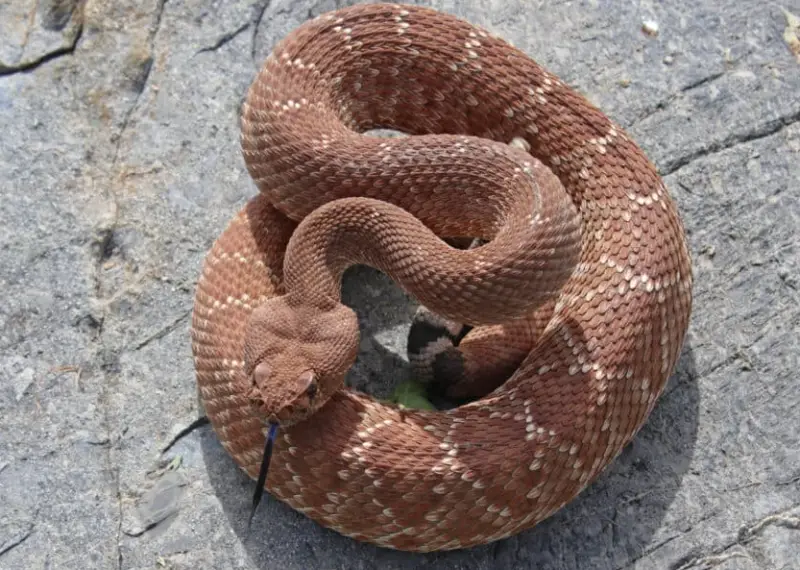
The Red Diamond Rattlesnake (Crotalus ruber), also known as the red rattlesnake, is a venomous species found in Southern California, Baja California, and the Gulf of California islands. It typically reaches around 39 inches in length and is distinguished by its faded red coloration.
Although considered the least venomous among rattlesnakes, its bite is still dangerous and potentially fatal, requiring prompt hospitalization and antivenom treatment for those affected.
Non-venomous snake species in California
Ringneck snake
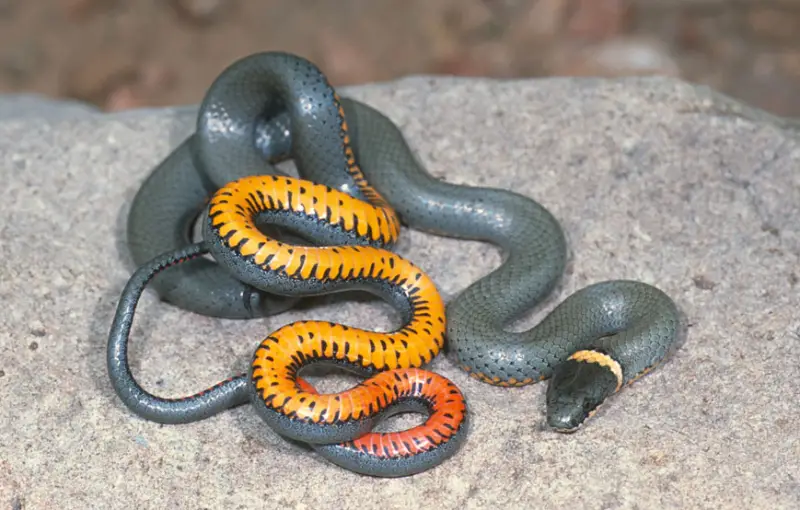
The Ringneck snake (Diadophis punctatus), also known as the ring-necked snake, is a small, non-venomous species characterized by its bicolored appearance. The dorsal side is green olive, while the underbelly is a bright orange or red.
Typically measuring between 10 and 15 inches in length, these snakes are commonly found in ground habitats where slugs and salamanders are abundant.
Ringneck snakes use constriction to subdue prey and may employ a small amount of venom as an additional method to immobilize smaller prey, despite not having a dedicated venom gland.
Desert nightsnake
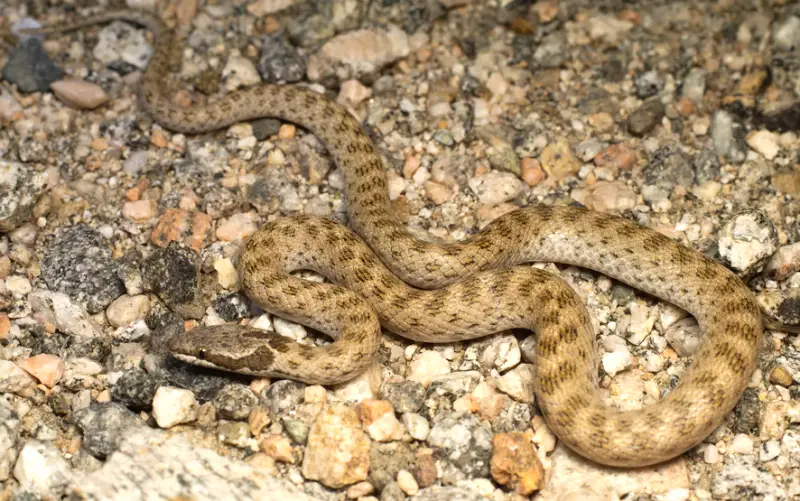
The Desert nightsnake (Hypsiglena chlorophaea) is a non-venomous species characterized by its bright underside and blotched gray and brown dorsal coloring. Preferring California’s chaparral, rocky terrains, and grasslands, it can also be found in woodlands elsewhere. These snakes grow to over 15 inches, with some reaching up to 26 inches in food-abundant areas.
They primarily feed on small amphibians. Although mildly venomous, their venom is used to subdue prey rather than for defense. Due to their coloration, Desert nightsnakes are sometimes mistaken for rattlesnakes.
Coast night snake
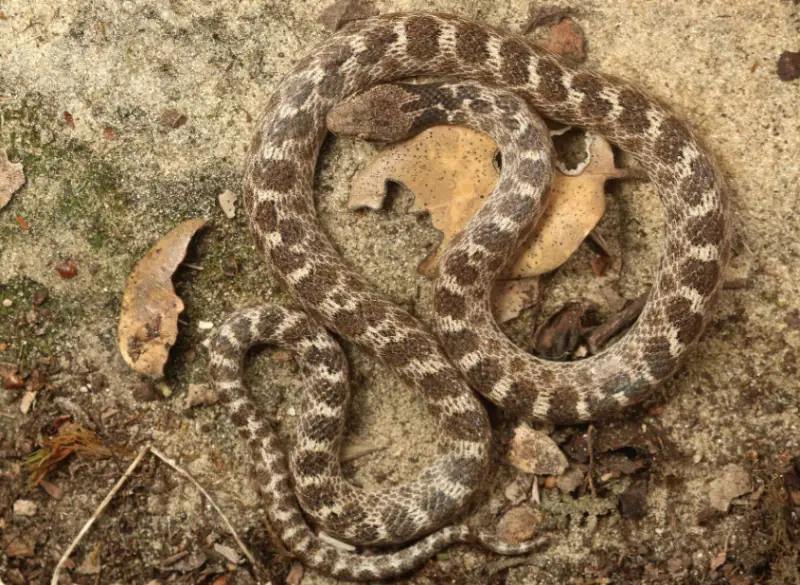
The Coast night snake (Hypsiglena ochrorhynchus) is a non-venomous, nocturnal species commonly found in Western California. Recognizable by its tan body with brown blotches, it is typically found in rocky terrains.
This elusive snake is most active at night, making it a rare sight during the day. Its diet includes both amphibians and insects. Mature Coast night snakes can grow up to 26 inches in length and are frequently encountered around the Central Valley.
California kingsnake
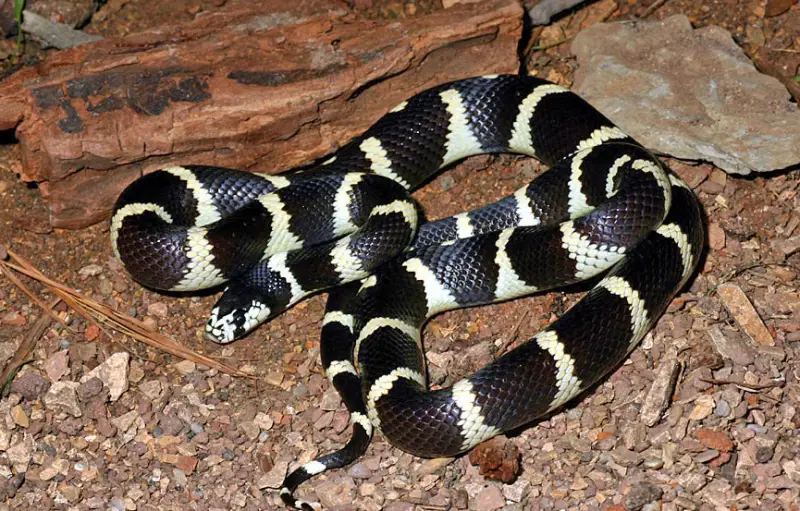
The California kingsnake (Lampropeltis californiae) is a common and non-venomous species in California, recognized by its dark and white banded body. This powerful constrictor can grow up to 3.5 feet in length. It uses its constriction to subdue prey, including reptiles, birds, and other juvenile snakes.
Notably, California kingsnakes are known to prey on other snake species and can even resist the venom of rattlesnakes. Additionally, they mimic rattlesnakes by wiggling their tails to produce a similar rattling sound as a defensive strategy.
Coast mountain kingsnake
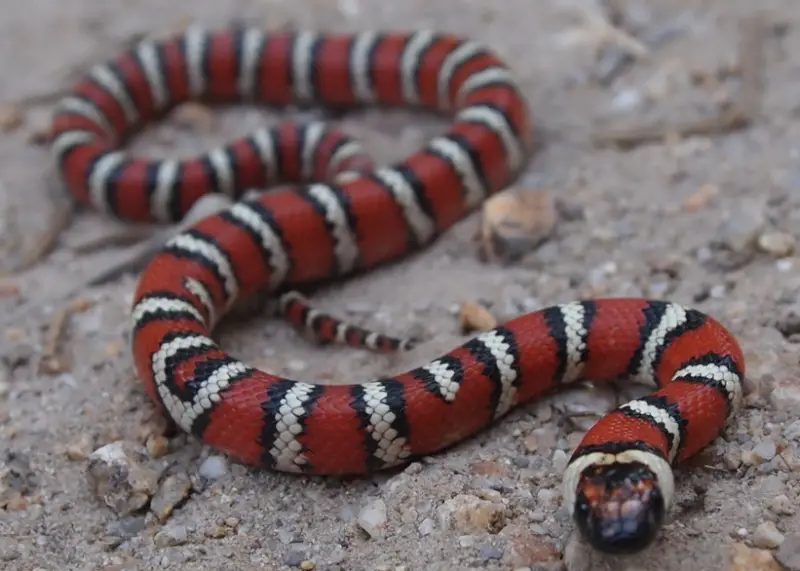
The Coast mountain kingsnake (Lampropeltis multifasciata) is a non-venomous species distinguished by its striking black, red, and white circular banding. Adaptable to diurnal, nocturnal, or crepuscular activity, it adjusts its behavior based on temperature.
During summer, it becomes more secretive and nocturnal, while in fall, it becomes diurnal and eventually goes into hiding starting in November. Preferring small mammals, birds, and bird eggs, this species can grow up to 33 inches long and is commonly found in the northern parts of California.
California mountain kingsnake
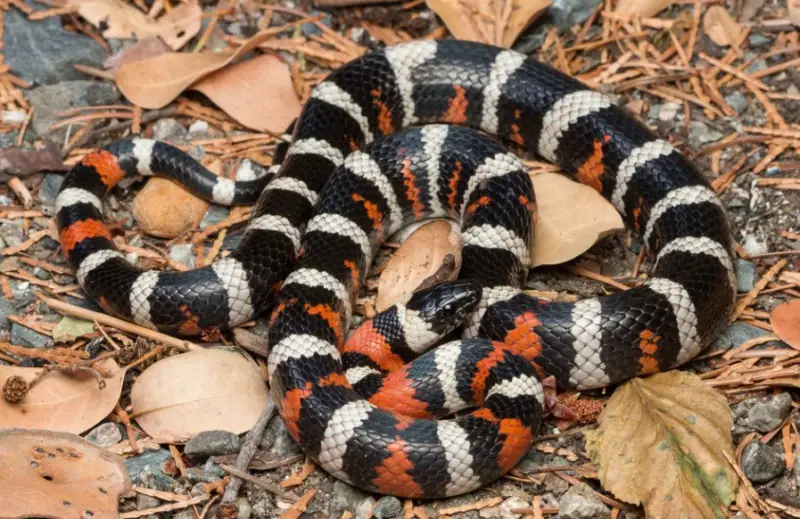
The California mountain kingsnake (Lampropeltis zonata) is a non-venomous species found in mountainous regions. It is easily recognizable by its red body with distinctive white crossbands bordered by black crossbands.
While similar to the California kingsnake, this species is endemic to North America, with its habitat extending southward into Baja California.
Coachwhip
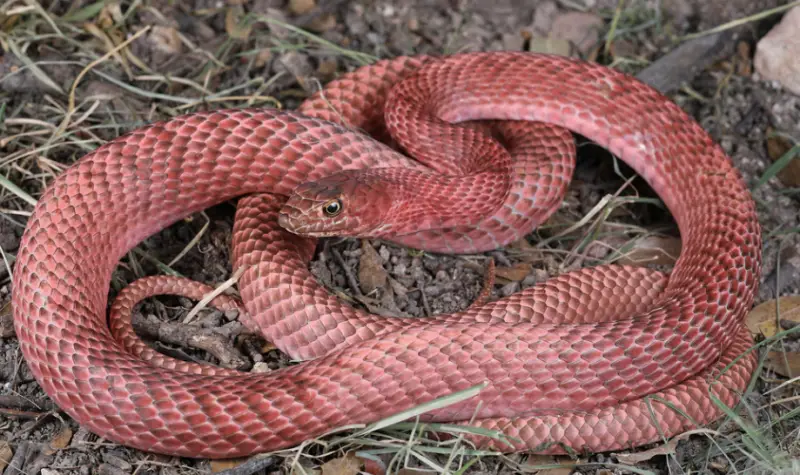
The Coachwhip (Masticophis flagellum), also known as the whip snake, is a non-venomous species commonly found in California. These diurnal snakes are frequently seen in grasslands, oil fields, farms, and woodlands. Notable for their large eyes and thin heads, Coachwhips are aggressive and fast, capable of growing up to 50 inches.
Although they are not venomous, their bites are quick and painful, often delivered without warning. Coachwhips can reach speeds of up to 4 miles per hour, enabling them to make a swift escape after biting.
Baja California coachwhip
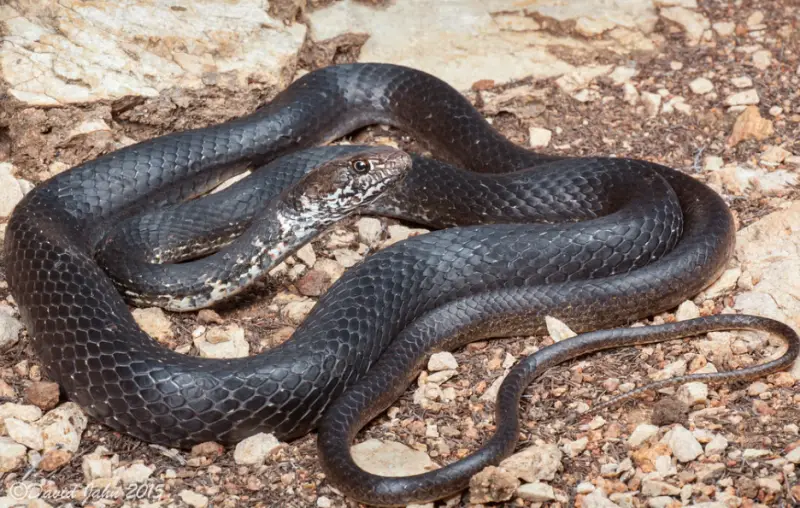
The Baja California coachwhip (Masticophis fuliginosus) is a non-venomous snake notable for its almost all-black body, though it can also appear in gray and blotched gray variations. Predominantly found in Baja California, this species breeds in northern Baja California and also ventures into grasslands in California.
Adapted to diurnal living, the Baja California coachwhip is often seen basking on roads during the day. Its varied diet includes small mammals, lizards, bats, and other small snakes.
California striped whipsnake
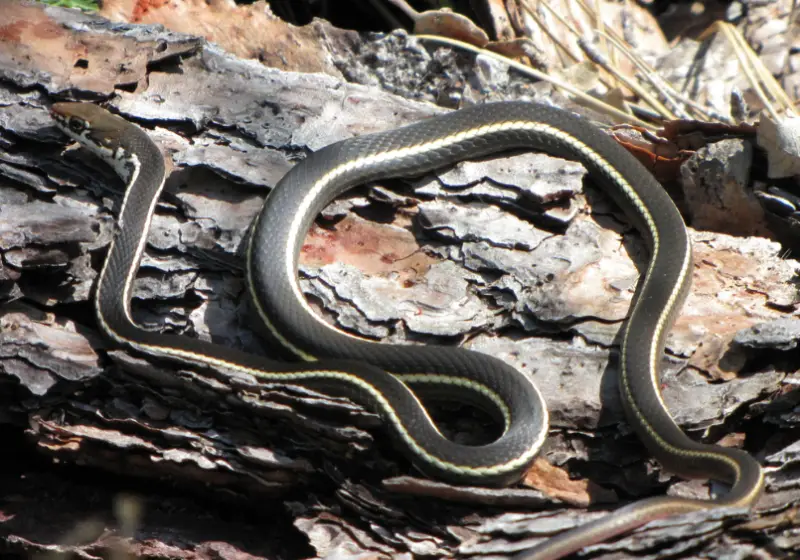
The California striped whipsnake (Masticophis lateralis), also known as the California whipsnake or striped racer, is a non-venomous species found throughout California. It inhabits a range of environments, including deserts, coastal areas, and chaparral.
This snake is easily identified by its olive-green body with pale yellow stripes running from head to tail. It is commonly seen in open spaces and varied terrains, such as chaparral, where it moves swiftly in search of prey.
Striped whipsnake
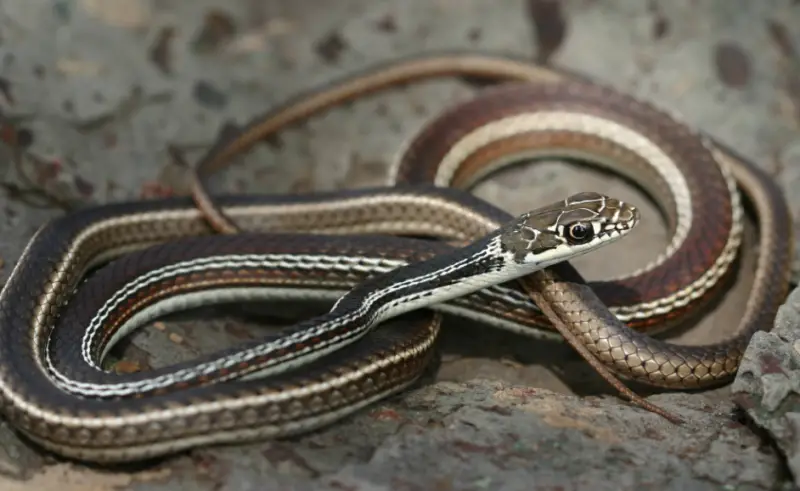
The Striped whipsnake (Masticophis taeniatus) is a non-venomous species easily recognized by its bright stripes running along its body. Found primarily in Northern California, it inhabits grasslands and forests.
Although non-venomous and generally not dangerous to humans, the Striped whipsnake is known for its speed and tends to flee rather than confront people. It is one of the fastest snake species in California.
Banded water snake
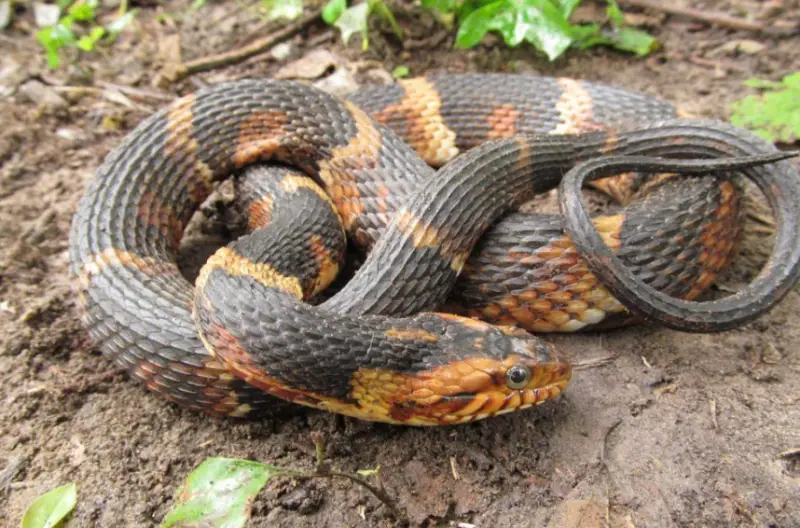
The Banded water snake (Nerodia fasciata), also known as the Southern water snake, is a non-venomous aquatic species. It can be identified by its dark green, gray, or orange body with distinctive stripes. Growing up to 42 inches in length, this snake is typically found in lakes and ponds, rarely straying far from water sources.
Its habitat overlap with other snake species, such as the venomous cottonmouth, often leads to confusion. Banded water snakes are also expanding their range and can be found on the outskirts of Los Angeles.
Western leaf-nosed snake
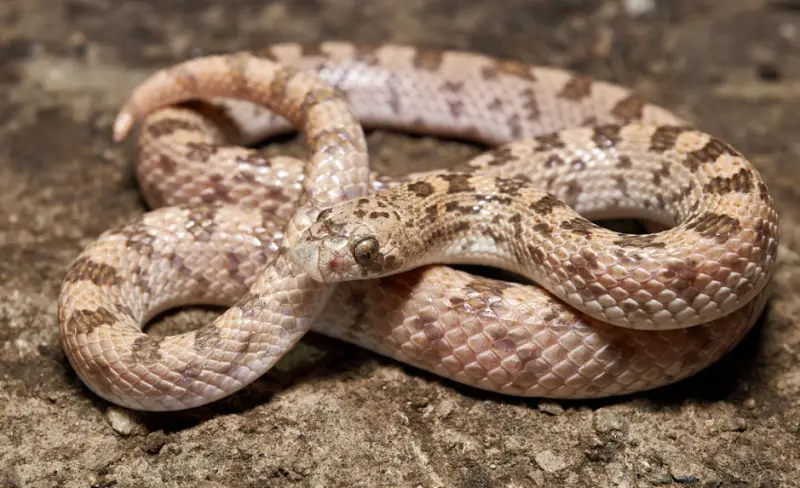
The Western leaf-nosed snake (Phyllorhynchus decurtatus) is a non-venomous species characterized by its gray body adorned with dark blotches, though variations in tan and pink are also seen. This nocturnal snake, once considered rare, is highly active at night, often found on paved roads in desert areas after sunset.
Its diet mainly consists of small lizards and lizard eggs. The Western leaf-nosed snake is found in the southern parts of California and extends into Baja California.
Gopher snake
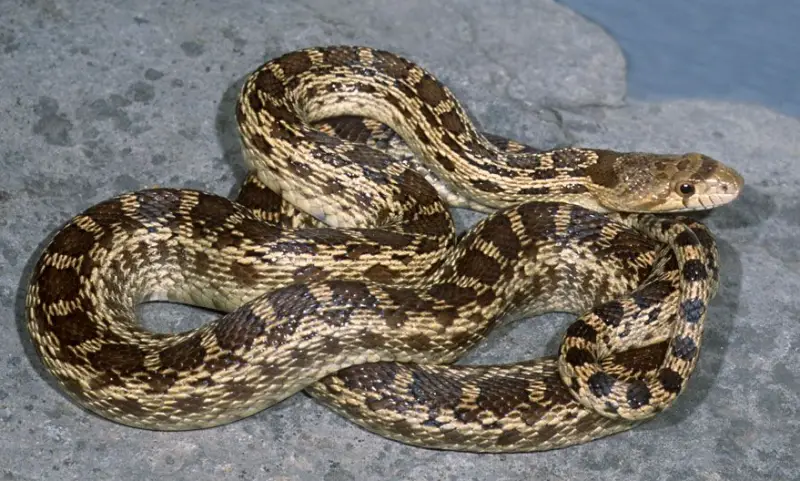
The Gopher snake (Pituophis catenifer), also known as the Pacific, coast, or Western gopher snake, is a non-venomous species that can grow between 2.5 and 9 feet in length. Highly versatile, it is capable of traveling on the ground, swimming, and climbing trees. Using constriction to subdue prey, Gopher snakes primarily feed on pocket gophers, rodents, rabbits, and birds.
Although they hiss loudly and may play dead by lying still to appear lifeless, they are not dangerous to people. Gopher snakes are particularly active in the spring as males search for mates.
Northern Rubber Boa
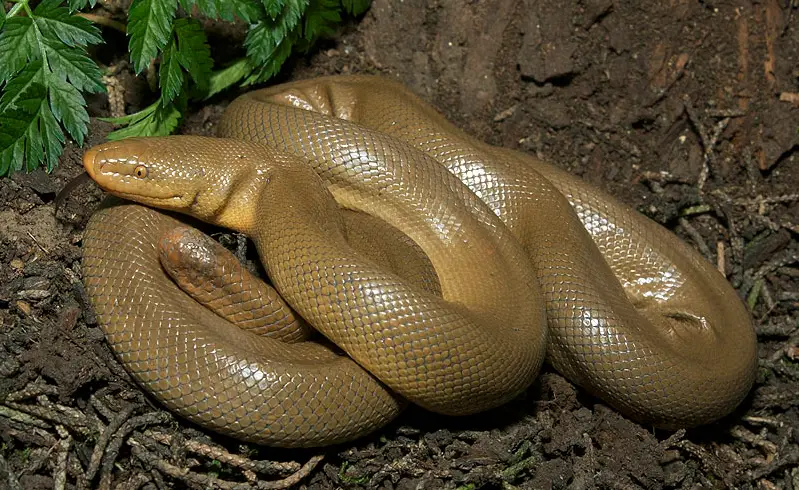
The Northern Rubber Boa (Charina bottae) is a non-venomous snake characterized by its plain brown coloration. This nocturnal species is often hidden during the day and is typically found in cool, shaded environments such as under rocks or logs or in rodent burrows.
It may show signs of previous encounters with rodents, such as bite marks. The Northern Rubber Boa is known for its secretive nature, making it challenging to spot in the wild.
Southern Rubber Boa
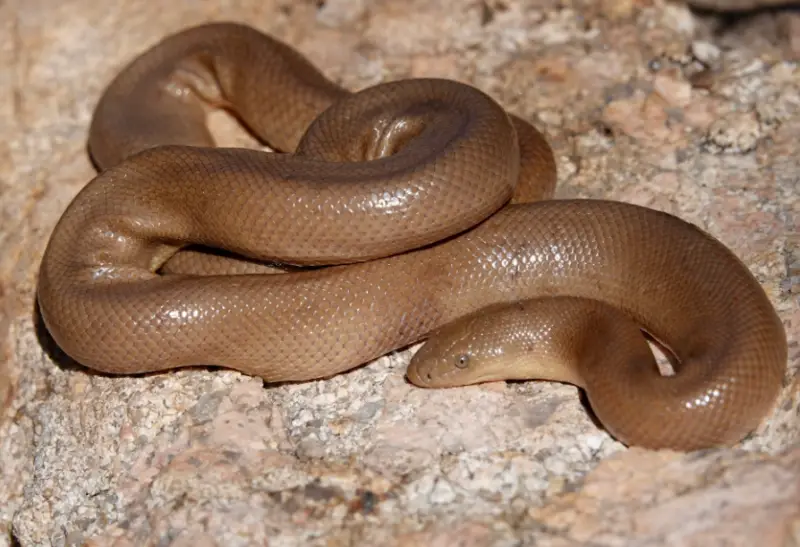
The Southern Rubber Boa (Charina umbratica) is a non-venomous snake with a uniform color, ranging from light to dark brown. It inhabits hardwood forests and demonstrates impressive agility, moving quickly on the ground, climbing, and swimming. This snake primarily feeds on small mammals, lizards, and occasionally small birds.
While generally avoiding humans, it may display defensive behavior, such as raising its tail to mimic a strike. The Southern Rubber Boa is occasionally active during the day, especially from April to June during its mating season, but often hides under large objects like logs and rocks.
Coastal Rosy Boa
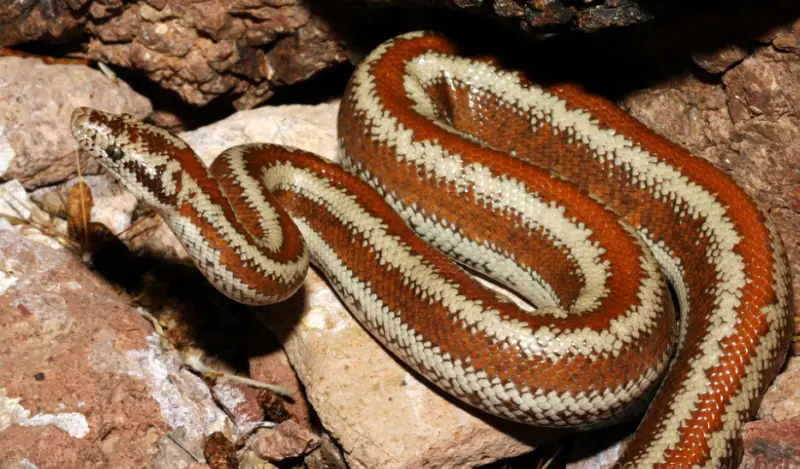
The Coastal Rosy Boa (Lichanura orcutti) is a non-venomous snake and a member of the Rosy Boa genus. Although it is sometimes referred to separately from the Desert Rosy Boa, both subspecies are now classified under the same Rosy Boa species.
Coastal Rosy Boas are characterized by their distinctive coloration and patterns, which contribute to their attractive appearance. They are commonly found along the coast and have adapted to their specific geographic regions within the Rosy Boa species.
Rosy boa
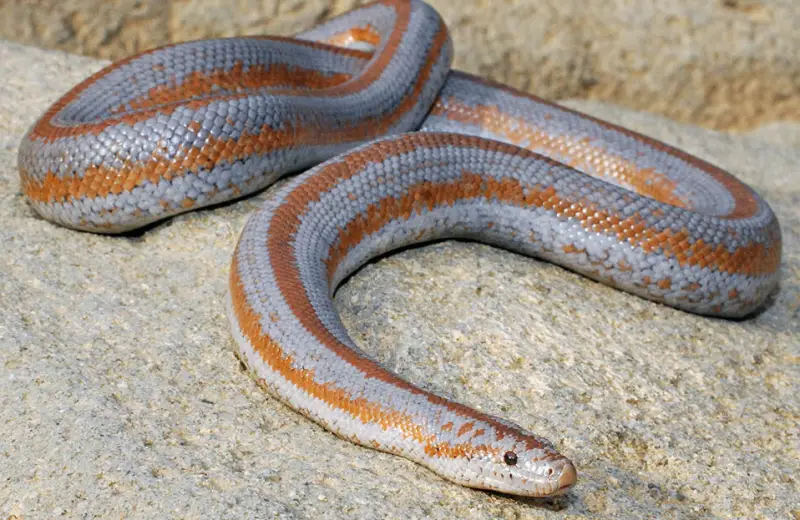
The Rosy Boa (Lichanura trivirgata), also known as the desert rosy boa, is a non-venomous species native to the U.S. It can grow up to 44 inches in length and is named for its rose-salmon coloration, which varies depending on its environment.
Found in Southern California and Baja California, the Rosy Boa is known for its docile nature and allows for safe handling. When threatened, it may release a foul odor as a defense mechanism.
Glossy snake
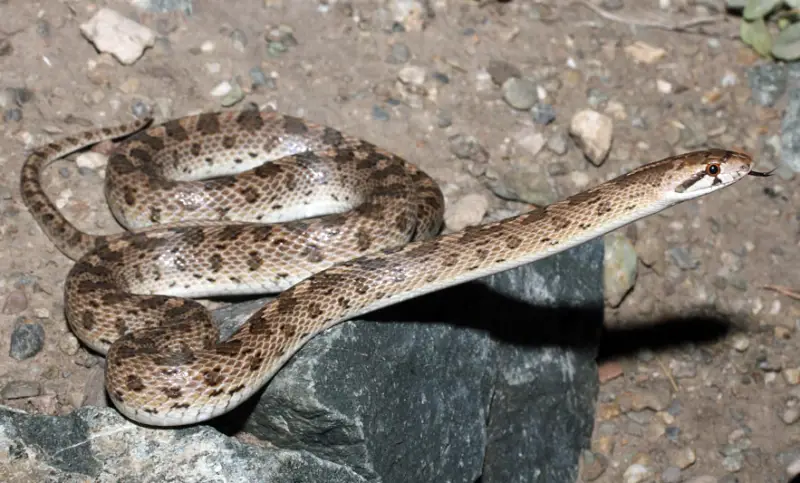
The Glossy Snake (Arizona elegans), also known as the faded snake, is a non-venomous species found in California’s chaparral regions. This nocturnal snake prefers to stay hidden under rocks and is rarely seen.
Glossy Snakes mainly feed on rodents at night but may emerge during the day in search of prey. Their secretive behavior and tendency to remain hidden in rodent burrows contribute to their perception as a less common species.
Western shovelnose snake
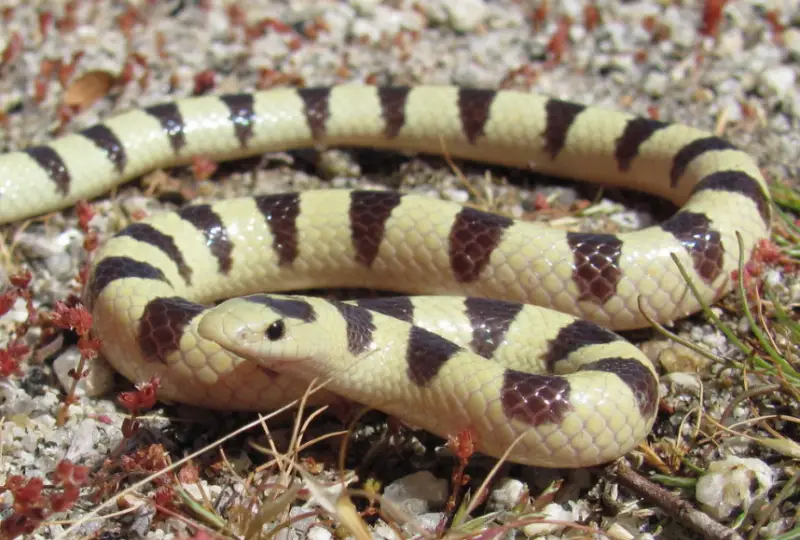
The Western shovelnose snake (Chionactis occipitalis) is a small, non-venomous snake, typically measuring between 11 and 17 inches in length. It is characterized by distinct brown bands across its body. This species is exclusive to Southern California’s desert regions, avoiding Northern California altogether.
Found in sandy areas, dunes, and rocky terrains with minimal vegetation, the Western shovelnose primarily feeds on insects rather than mammals. Its unique appearance and habitat preferences make it relatively easy to identify in its natural environment.
Eastern racer
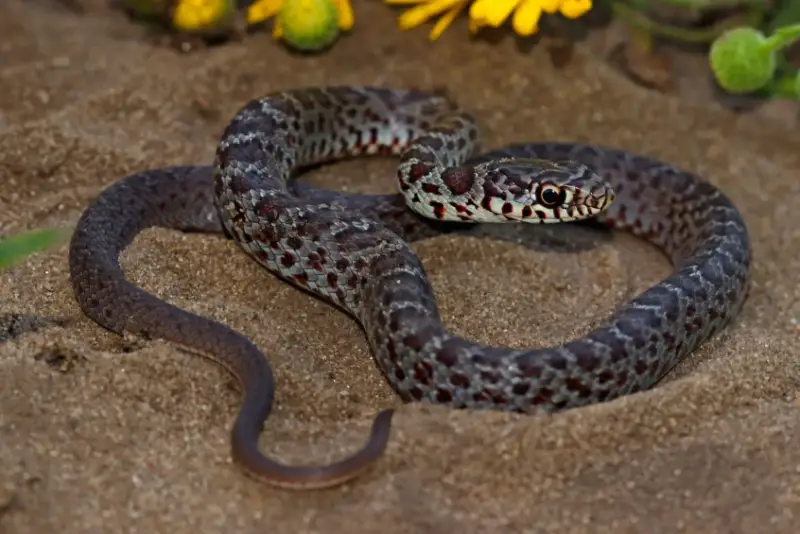
The Eastern racer (Coluber constrictor) is a non-venomous, fast-moving snake known for its varied coloration. While black racers are common, California also hosts rarer variants in shades of brown with or without blue undertones.
These snakes are frequently found in tall grass, where they lift their heads above the grass to survey their surroundings. Despite the name, Eastern racers are not constrictors; instead of suffocating prey, they use their bodies to pin it down and prevent escape.
Forest sharp-tailed snake
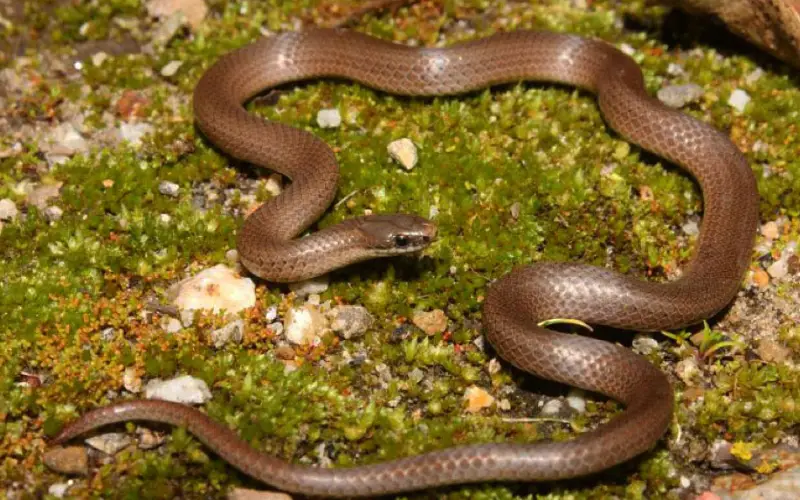
The Forest sharp-tailed snake (Contia longicaudae) is a non-venomous species found in California’s forests. It features a distinct dark gray head with olive undertones, while its body is typically brown or black with a light underbelly edged in black scales.
This small, secretive snake is often hidden during the day and may emerge after rain to hunt. Known for its sharp teeth, the Forest sharp-tailed snake effectively grasps slippery prey, such as salamanders, making it well-adapted to its environment.
Sharp-tailed snake
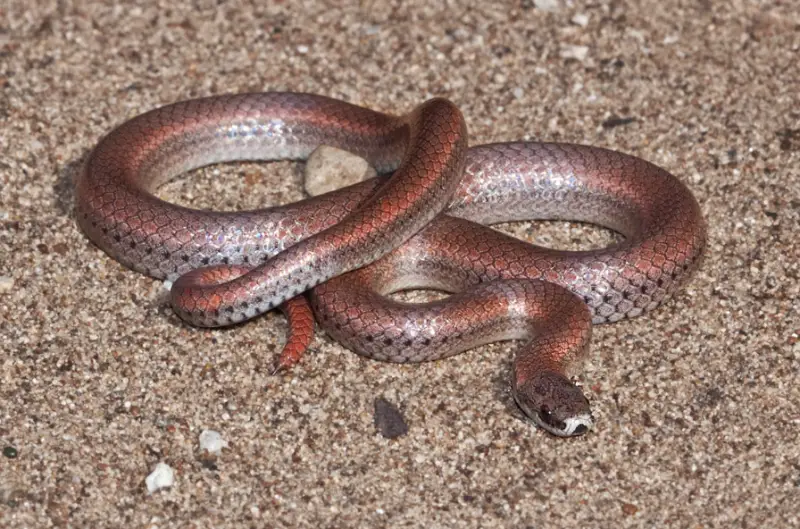
The Sharp-tailed snake (Contia tenuis), also known by several common names such as the Brown snake and Pacific ground snake, is a small, non-venomous species found in urban areas across California. Growing between 12 and 18 inches in length, it is distinguished by its sharp tail and banded body coloring. A burrowing species, it thrives in soft soil, where it searches for slugs.
Typically found in gardens and parks, the Sharp-tailed snake avoids open spaces and is often seen where large stones or logs have been removed.
Long-nosed snake
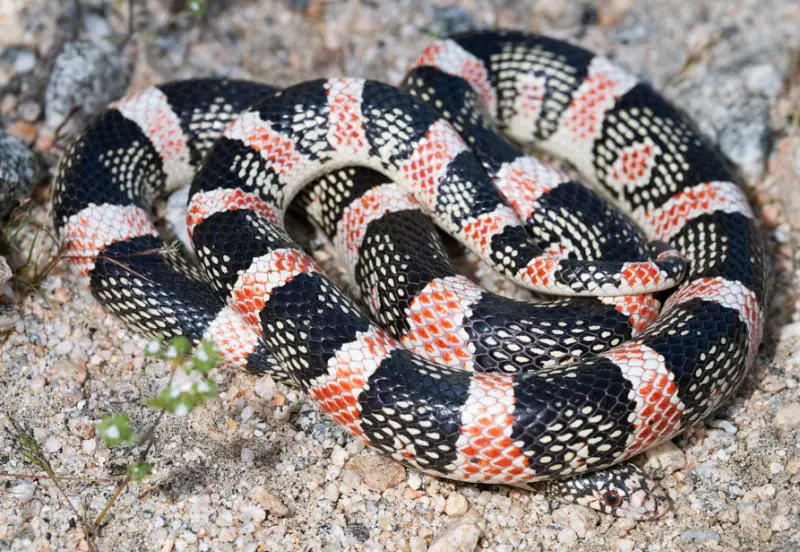
The Long-nosed snake (Rhinocheilus lecontei) is a non-venomous species often mistaken for coral snakes due to its red and black coloration and upward-facing snout. This nocturnal snake is rarely seen during the day and prefers to stay in shaded grasslands.
Like many other California snakes, it primarily feeds on amphibians. To protect itself from predators, including larger snakes, the Long-nosed snake can release a foul odor and even blood to mimic death while remaining motionless. It is most commonly observed in late spring and early summer during mating season.
Western patch-nosed snake
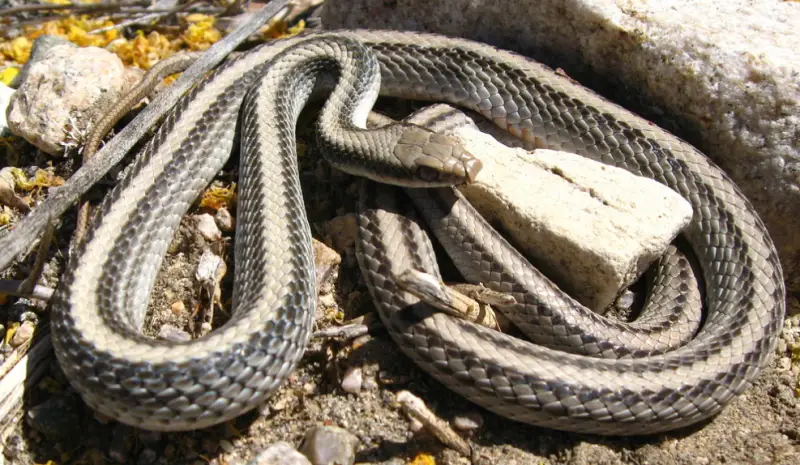
The Western patch-nosed snake (Salvadora hexalepis) is a non-venomous, small snake commonly found in desert scrubs. As a diurnal species, it actively chases a variety of small prey, including mammals, lizards, grasshoppers, and even the eggs of other snakes.
Characterized by its distinctive large rostral scale on the nose and striped body, this snake is generally docile and not dangerous to humans. Its calm demeanor makes it a suitable candidate for a pet snake.
California lyresnake
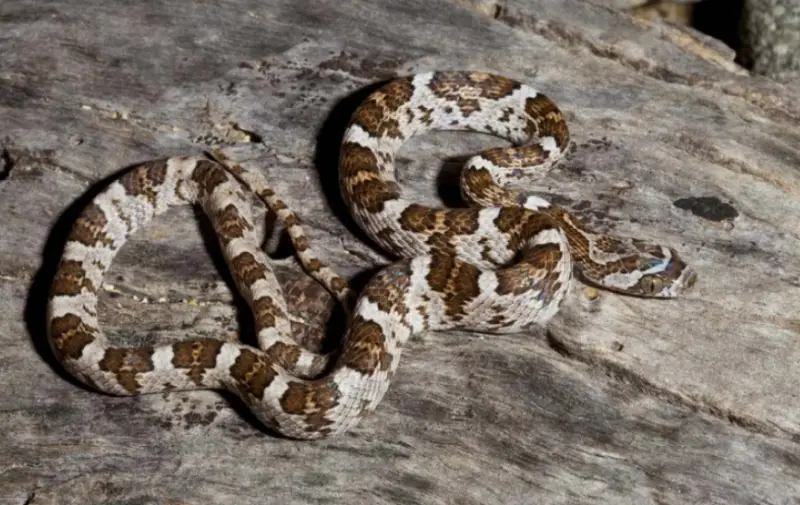
The California lyresnake (Trimorphodon lyrophanes) is a species endemic to California, recognized by its small to medium-sized body that can grow up to 47 inches and its vertical pupils resembling those of cats. The snake’s body is typically gray and brown.
Mildly venomous, the California lyresnake’s bite can be lethal to small animals but is not deadly to humans. However, its bite is quite painful, especially when the snake manages to latch on, allowing more saliva to be introduced through its strong fangs.
This nocturnal species is active during both good weather and heavy rainfall, often hunting lizards immediately after the rain stops. Mating occurs in the spring, with females laying clusters of up to 10 eggs at the beginning of summer.
Western threadsnake
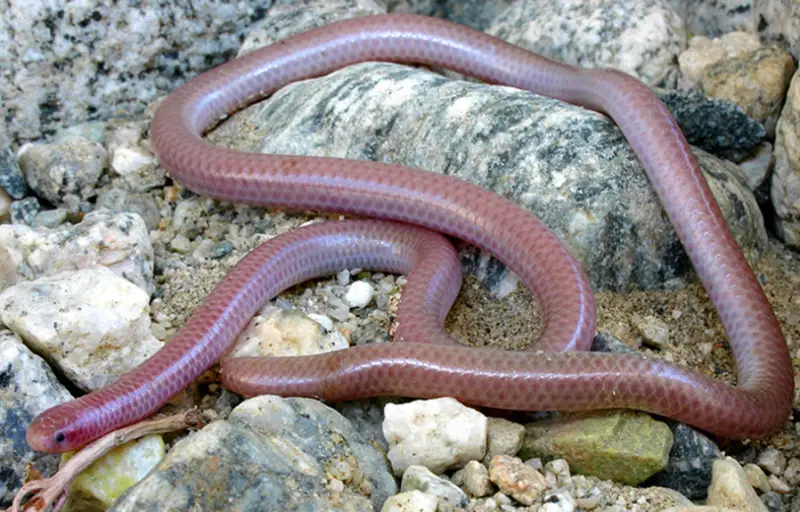
The Western threadsnake (Rena humilis), also known as the Western blind snake or Western slender blind snake, is a burrowing species commonly found in California. These elusive snakes are rarely seen above ground due to their underground lifestyle.
Resembling earthworms, Western threadsnakes are characterized by their slender, pink bodies and robust, small heads, which are adapted for digging. Despite their rarity at ground level, they are widespread beneath the surface, sometimes burrowing as deep as 66 feet.
These snakes are blind, an evolutionary adaptation to their subterranean existence. Their diet primarily consists of small insects, particularly ants, which they often consume by invading ant nests.
Brahminy blind snake
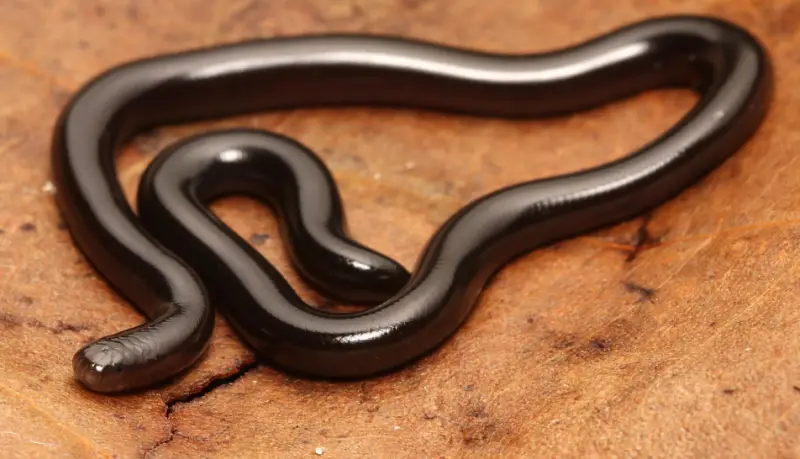
The Brahminy blind snake (Indotyphlops braminus), also known as the flowerpot snake, is a small, fossorial species often mistaken for an earthworm due to its slender, scale-covered body. These snakes lack vision and live underground, thriving in humid environments like farms and suburban areas.
Uniquely, the Brahminy blind snake reproduces through parthenogenesis, meaning all individuals are female and can reproduce without mating, producing genetically identical offspring.
Their diet consists mainly of ants and termites, and they can temporarily inhabit ant nests to feed. They are usually found under logs and rocks where moisture is abundant.
Western ground snake
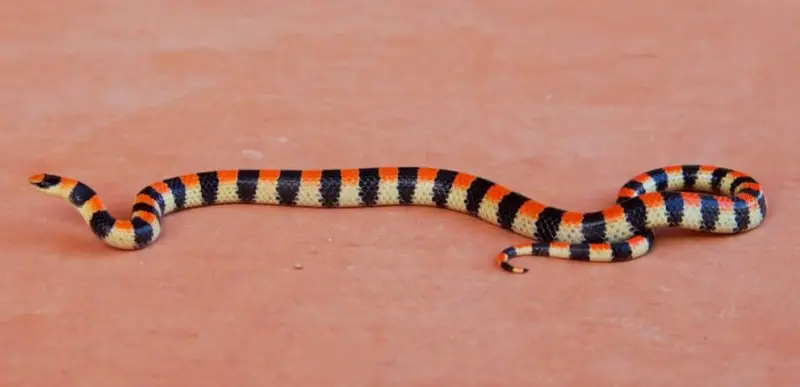
The Western ground snake (Sonora semiannulata), also known as the common or variable ground snake, is a non-venomous species that inhabits loose, rocky ground. Typically orange with black stripes, this snake can exhibit various colors due to inbreeding.
Preferring to stay hidden underground, it emerges to feed on a range of insects and invertebrates, including spiders, crickets, and centipedes. Females lay eggs, which they do through the summer shortly after mating, as they do not carry live young.
Southwestern blackhead snake
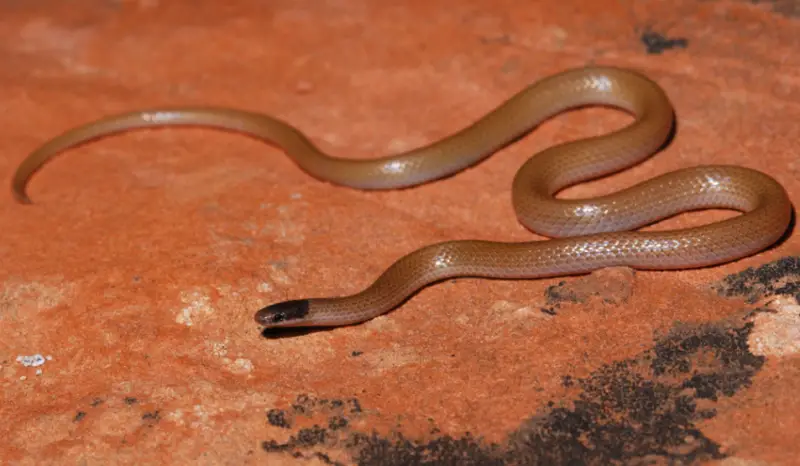
The Southwestern blackhead snake (Tantilla hobartsmithi), also known as Smith’s blackhead snake, is a non-venomous species native to the southwestern U.S. and Mexico. This small snake typically grows to around 8 inches in length and is distinguished by its brown coloring and small size. It primarily feeds on a variety of insects, favoring softer ones that are easier to consume.
While not dangerous to humans due to its mild venom, the Southwestern blackhead snake’s saliva can paralyze small insects. It is commonly found in loose soil within grasslands, woodlands, and deserts.
Western black-headed snake
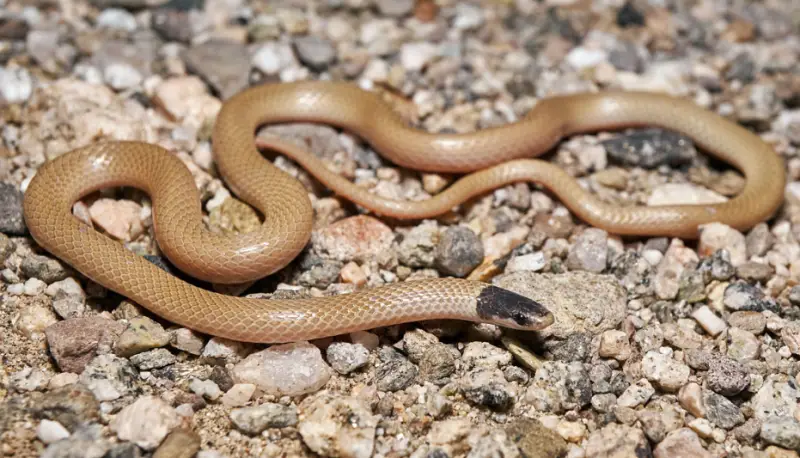
The Western black-headed snake (Tantilla planiceps), also known as the California black-headed snake, is a non-venomous species recognized by its black head with a white collar and brown body. This small snake typically grows to a maximum length of 15 inches.
It is known for its secretive nature, spending most of its life underground. The Western black-headed snake is found in woodlands and deserts, often in remote, higher-moisture areas within arid terrains.
Aquatic garter snake
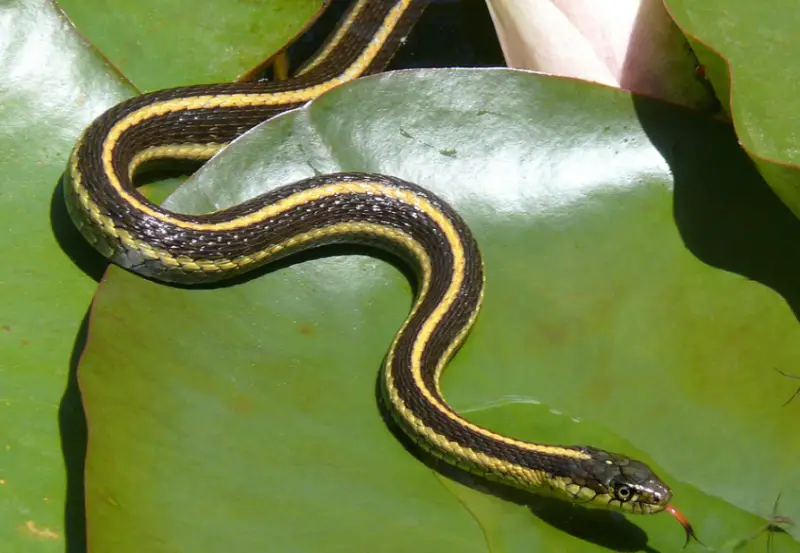
The Aquatic garter snake (Thamnophis atratus) is a non-venomous species well-adapted to an aquatic lifestyle. Characterized by its green body with long yellow stripes running from head to tail, this coloration aids in camouflage within marshes and bushland.
The Aquatic garter snake can swim beneath the surface and flick its tongue, creating the illusion of flies to deceive some prey. This effective camouflage helps it remain undetected while hunting.
Sierra garter snake
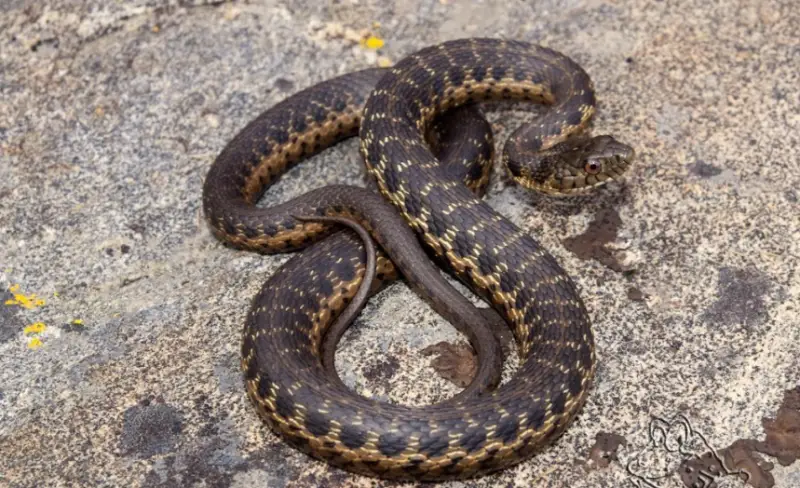
The Sierra garter snake (Thamnophis couchii), also known as Couch’s garter snake or the Western aquatic garter snake, is a non-venomous species with a high adaptability to its environment.
Active nearly year-round, it is commonly found in or near rivers, where it can swim at the bottom in search of fish. Besides fish, this snake also consumes amphibians found near rivers and streams.
Although it was once believed to be poisonous, the toxins present are from the salamanders it preys on and can remain in the snake’s system for up to a few weeks.
Terrestrial garter snake
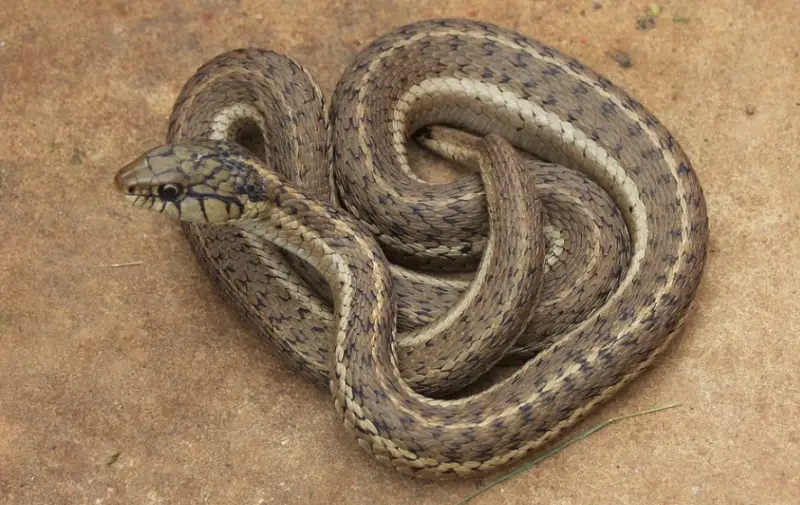
The Terrestrial garter snake (Thamnophis elegans), also known as the Western terrestrial garter snake, is a non-venomous species that can grow up to 41 inches in length. Characterized by its colorful appearance, this snake often features long white stripes along its body.
As a constrictor, it uses its ability to constrict prey to subdue terrestrial animals, such as rodents. This makes it one of the few garter snakes that regularly employs constriction as a tactic to overpower its prey.
Giant garter snake
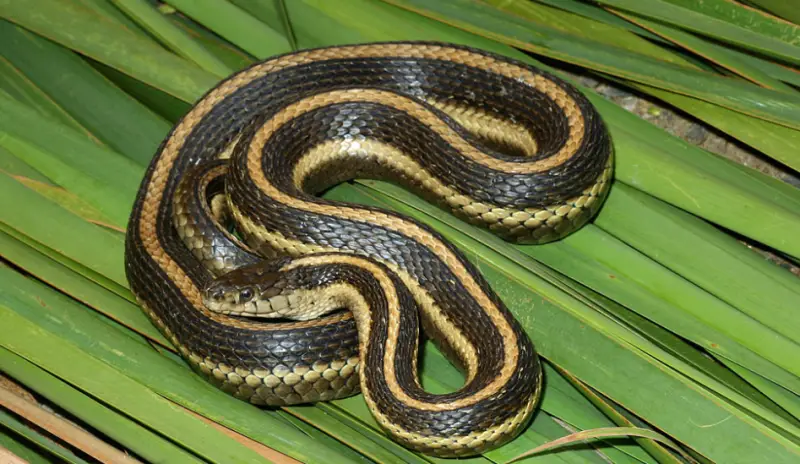
The Giant garter snake (Thamnophis gigas) is a non-venomous species distinguished by its green-olive, brown, or black coloration, with a contrasting white or yellow dorsal stripe and a bright underbelly. As a primarily aquatic snake, it utilizes vegetation near water sources for concealment and may use animal burrows to cool off during hot summer days.
Its diet reflects its semi-aquatic nature, including fish, frogs, and tadpoles. Named for its large size, the Giant garter snake can grow between 35 and 65 inches, making it one of the largest snake species in California.
Two-striped garter snake
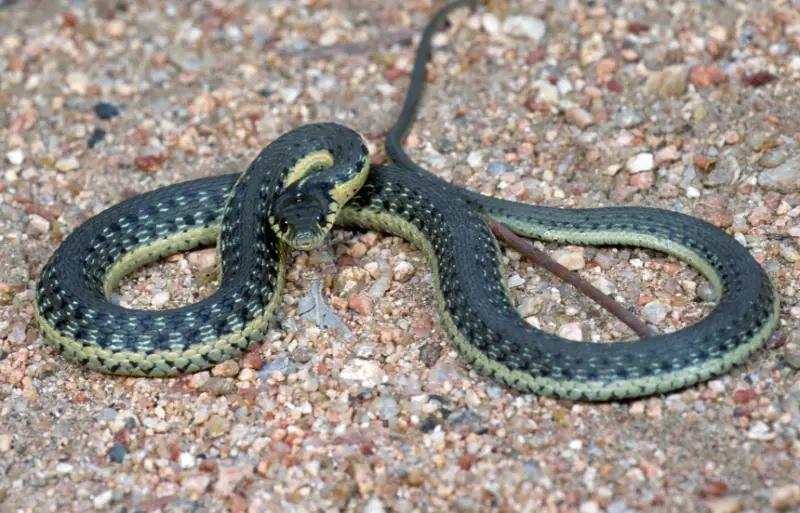
The Two-striped garter snake (Thamnophis hammondii) is a non-venomous species named for the stripes that run along its body, though some individuals may have no stripes at all. Its green coloration provides effective camouflage in semi-permanent water sources, helping it remain hidden from predators and prey.
This snake is known for its diet of amphibians and fish. It is commonly found in central California and extends south into Baja California.
Checkered garter snake
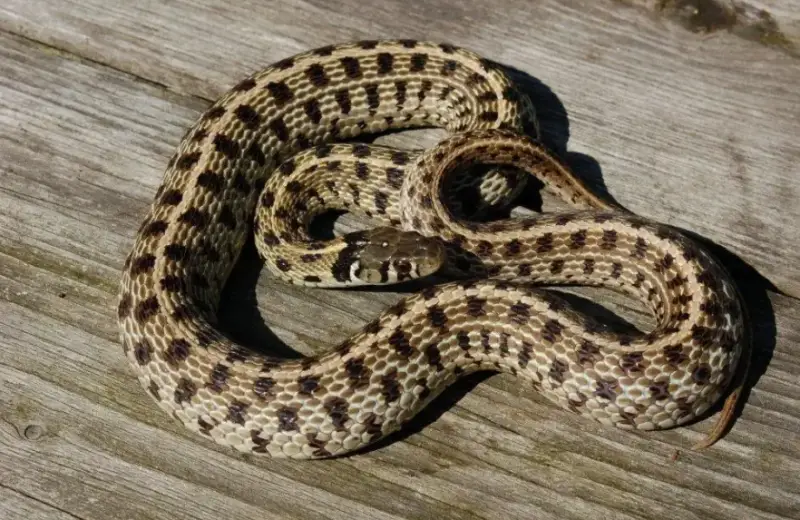
The Checkered garter snake (Thamnophis marcianus) is a non-venomous species recognized by its green body with a distinctive checkerboard pattern. Although mildly venomous, this venom is primarily effective against small fish and earthworms rather than humans.
The species can digest toads and prefers living in grasslands near water sources. This habitat provides ample opportunities for the snake to hunt amphibians, which make up a significant portion of its diet, over rodents.
Northwestern garter snake
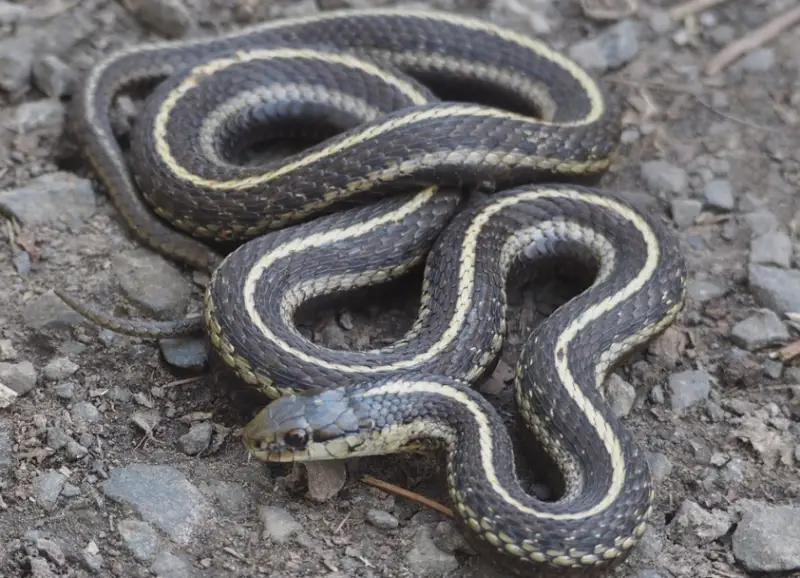
The Northwestern garter snake (Thamnophis ordinoides) is a non-venomous species identified by its brown, green, or gray coloring. These snakes can live up to 15 years and are generally solitary, using pheromones to attract mates during the breeding season. Although they are primarily terrestrial and diurnal, they are known to avoid human interaction by quickly retreating into vegetation.
This species has a varied diet, primarily feeding on slugs but also consuming fish, toads, and even toxic salamanders when necessary. The Northwestern garter snake is most commonly found in the far northern regions of California and Oregon.
Common garter snake
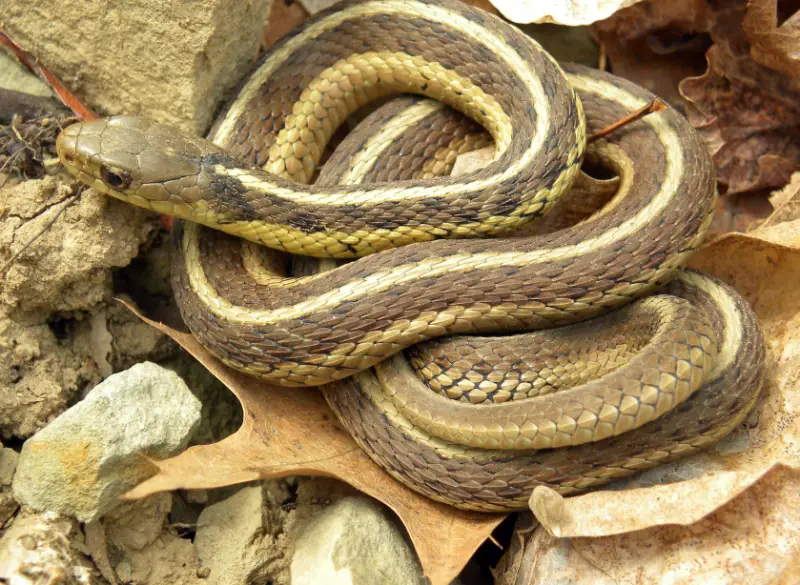
The Common garter snake (Thamnophis sirtalis) is a non-venomous species typically identified by its three long stripes, which can appear in various colors. Growing up to 55 inches, these snakes can live up to 10 years in the wild.
Common garter snakes are solitary and primarily interact with others of their species during the mating season. As efficient predators, they primarily feed on small fish and amphibians, including toads. Notably, the Common garter snake is immune to the toxins found in toads, which would be lethal to many other predators.
This species also faces natural threats from predators such as crows and hawks.
Sonoran lyre snake
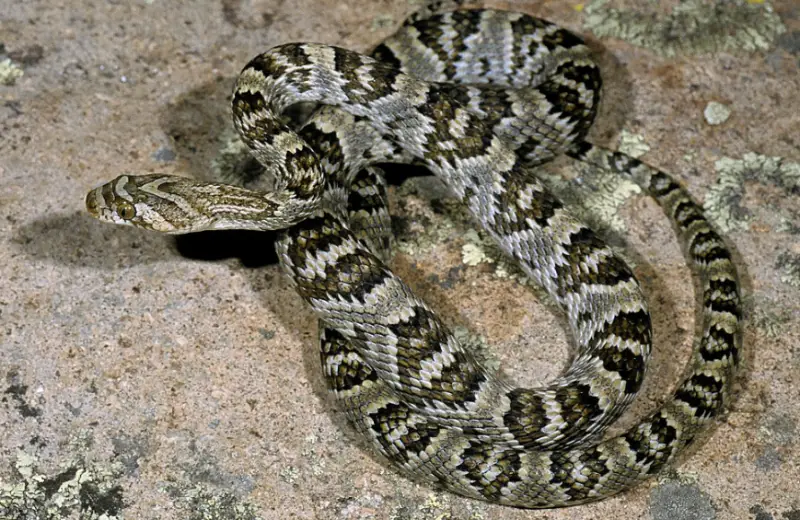
The Sonoran lyre snake (Trimorphodon lambda) is a mildly venomous species found in California. While its venom is not considered dangerous to humans, these snakes should still be approached with caution as their bites can cause pain and redness.
This nocturnal species is elusive, becoming even more secretive during mating. They primarily feed on lizards and can grow to over 40 inches depending on their habitat.
Identified by their brown or gray bodies, Sonoran lyre snakes use defensive mimicry to protect themselves from predators. They vibrate their tails like rattlesnakes and may quickly raise their heads to strike if threatened.

